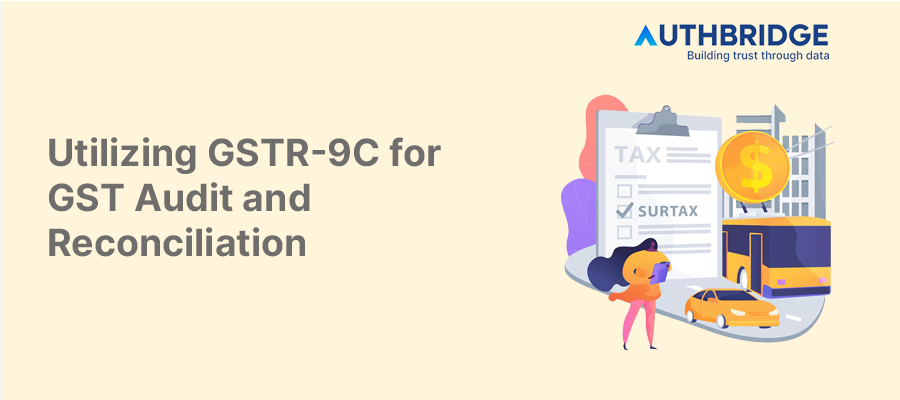Mastering GSTR-9C: A Comprehensive Guide To GST Audit And Reconciliation

1. Introduction to GSTR-9C
Purpose and Overview
GSTR-9C is a reconciliation statement required to be filed annually by taxpayers whose turnover exceeds Rs. 5 crores during a financial year. It serves as a mechanism to reconcile the data provided in the annual return (GSTR-9) with the audited financial statements of the taxpayer. This form plays a crucial role in ensuring the accuracy of the GST returns filed and aids in the audit process by GST authorities.
Eligibility Criteria
The requirement to file GSTR-9C extends to all taxpayers who have crossed the specified turnover threshold of Rs. 5 crores in a financial year. This includes all forms of businesses such as manufacturers, service providers, and traders who are registered under GST. The form acts as an audit document, where discrepancies, if any, between the GST returns and the financial statements are reported and rectified.
2. Key Components of GSTR-9C
Part-A: Reconciliation Statement
The reconciliation statement in Part-A of GSTR-9C is designed to ensure that the information provided in the annual return (GSTR-9) matches the taxpayer's audited financial statements. This part is divided into several sections, each focusing on different aspects of reconciliation:
- Basic Details: Includes financial year, GSTIN, legal name, and trade name.
- Reconciliation of Turnover: Compares the turnover declared in the audited financial statements with that declared in GSTR-9, adjusting for any discrepancies.
- Reconciliation of Tax Paid: Ensures that the tax amounts paid as per the financial statements align with those reported in GSTR-9.
- Reconciliation of Input Tax Credit (ITC): Matches the ITC claimed in GSTR-9 with the audited accounts, highlighting any differences.
Part-B: Certification
Part-B of GSTR-9C contains the certification to be filled out by the auditor or the taxpayer, depending on whether it's a self-certified reconciliation statement or if it has been audited by a third-party. This section verifies the accuracy of the information provided in Part-A and includes:
- Auditor's Recommendation: Suggestions or observations made by the auditor regarding the GST compliance and reconciliation process.
- Declaration: A declaration by the taxpayer or the auditor certifying the truthfulness and accuracy of the information provided in GSTR-9C.
3. Preparing GSTR-9C
Reconciliation of Turnover
This involves a detailed comparison of the turnover figures reported in the audited financial statements with those declared in the annual GST return (GSTR-9). Adjustments may be required for unbilled revenue, advances, deemed supplies, and other factors affecting turnover.
Reconciliation of Tax Paid
Taxpayers must reconcile the tax amounts paid according to their financial statements with the tax amounts declared in GSTR-9. This includes a detailed analysis of tax rates, tax liabilities, and any discrepancies that need to be addressed.
Reconciliation of Input Tax Credit
The ITC availed as per the financial statements is compared with the ITC claimed in GSTR-9. Discrepancies may arise due to ineligible credits, differences in ITC entitlement, or errors in reporting, which need to be reconciled.
4. Common Challenges and Solutions
Mismatch in Turnover
Discrepancies between the reported turnover in GSTR-9 and the audited financial statements can arise due to several reasons, such as unreported sales or differences in accounting policies. Regular reconciliation and maintaining detailed records can help mitigate these issues.
Differences in ITC Claimed
Variances in ITC may occur due to errors in claiming credits, ineligible expenses, or mismatches with supplier declarations. Taxpayers should conduct regular ITC reconciliations and consult with tax professionals to ensure accurate ITC claims.
Tax Liability Adjustments
Adjustments to tax liabilities may be required if discrepancies are identified during the reconciliation process. Taxpayers should review their tax payments and liabilities regularly and make necessary adjustments in subsequent returns or through DRC-03.
5. Filing Process and Deadlines
Offline Utility Tool
The GSTR-9C form can be prepared using the offline utility tool provided by the GST portal. This tool facilitates the preparation of the reconciliation statement by allowing taxpayers to input data offline before uploading it to the GST portal.
Submission on GST Portal
Once prepared, the GSTR-9C form, along with the reconciliation statement and certification, must be uploaded to the GST portal. The form is filed electronically, and taxpayers must ensure that it is submitted by the prescribed deadline to avoid penalties.
6. Best Practices for Error-Free Filing
Accurate Record-Keeping
Maintaining accurate and detailed records of all transactions, invoices, and tax payments is crucial for error-free filing of GSTR-9C. This facilitates easier reconciliation and ensures compliance with GST regulations.
Regular Reconciliation
Taxpayers should regularly reconcile their books of accounts with the GST returns filed throughout the year. This practice helps in identifying and rectifying discrepancies well before the filing of GSTR-9C.
Consultation with Professionals
Seeking the assistance of GST professionals or auditors can provide valuable insights into the reconciliation process and ensure that the GSTR-9C is prepared accurately, reflecting the true state of GST compliance.
By following these guidelines, taxpayers can effectively utilize GSTR-9C for GST audit and reconciliation, ensuring compliance and minimizing discrepancies in their GST filings.
Category

Abhinandan Banerjee
(Associate Manager - Marketing)
Abhinandan is a dynamic Product and Content Marketer, boasting over seven years of experience in crafting impactful marketing strategies across diverse environments. Known for his strategic insights, he propels digital growth and boosts brand visibility by transforming complex ideas into compelling content that inspires action.



